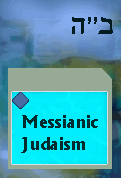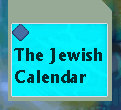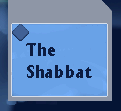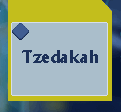
The Month
So far, for the reckoning of the day the calendar uses the sun – actually the appearance of the rising and the setting of the sun - for the week the account of creation, now, for the month - the next division of time based on the observance of the celestial bodies - the Jewish calendar uses the moon. Therefore, the Jewish calendar is said to be a lunar (from a Latin word for moon) calendar, which is approximately 29 and ½ days, the period of time in which the moon circles the earth once.
Exodus 12: 2 reads: “This month shall be to you the beginning of months; it shall be the first month of the year to you.” This passage refers to the spring month of Aviv when Passover is to occur. Unfortunately the post biblical calendar that Hillel II produced did not follow this biblical counting of the months, but the rabbinical interpretation that the earth was created in the seventh month, the month of Tishrei in the fall, and thus the month of Tishrei is instead the beginning month of the Jewish calendar, as we have it today.
The Talmud (Mas. Rosh Hashanah) tells us that the months of the Jewish calendar received their names from the Babylonians at the time when the Jews were in exile (560 BCE). These names, based on the order of today’s calendar, are as follows:
Tishrei, Cheshvan, Kislev, Tevet, Shevat, Adar, Nisan, Iyar, Sivan, Tammuz, Av and Elul.
The Bible usually mentions the Hebrew months by number starting with the spring equinox, as mentioned in Exodus above. For example Leviticus 23:24 says: “In the seventh month on the first of the month, you shall have a Shabbat, a reminder by blowing of trumpets, a holy convocation” - this is known today as Rosh haShanah, the secular New Year. Still the Bible mentions four months by name:
- Aviv, the 1st month of the biblical calendar (Deuteronomy 16:1) which is Nisan, the 7th Babylonian,
- Ziv, the 2nd month (1 Kings 6:1) is Iyar, the Babylonian 8th,
- Ethanim, the 7th month (1 Kings 8:2) is Tishrei, the Babylonian 1st,
- Bul, the 8th month (1 Kings 6:38) is Cheshvan, the Babylonian 2nd.
Because the revolution of the moon around the earth takes approximately 29 and 1/2 days, the months alternate between 29 and 30 days. A month of thirty days is called MALAIM - FULL. A month of twenty-nine days is called CHASARIM - DEFICIENT. The first month, the month of Tishrei, has 30 days, the second 29 and so on.
The Hebrew name for month is Chodesh, which means Renewal, and begins with the reappearance – the first tiny sliver appearance - or renewal, of the moon. This first day of the month is called Rosh Chodesh, New Moon, which literally means Head of the Month. Because one revolution of the moon around the earth takes 29 and ½ days, the last day of the months which have 30 days is also counted as Rosh Chodesh; therefore, Rosh Chodesh alternates from one to two days, as months alternate from 29 to 30 days. For example, Rosh Chodesh Iyar is two days – last day of Nissan and first day of Iyar – because Nissan, the preceding month, has 30 days, but Rosh Chodesh Sivan, the following month, is one day because Iyar has 29 days only.
The months of Kislev and Cheshvan may have either one day or two days for the New Moon and are called irregular months. They vary from 29 to 30 days in order to regulate the occurrence of holidays, so as to prevent the Day of Atonement - Yom Kippur, the day of fasting - from occurring either on Friday or Sunday, because that would be in conflict with the observance of the Shabbat. It cannot occur on Friday because while fasting one cannot prepare for Shabbat, and it cannot occur on Sunday because the closing of the Shabbat will interfere with the beginning of fasting and of the Yom Kippur’s Kol Nidrei service. But it can occur on Shabbat as Yom Kippur is called Shabbat Shabbaton, the Shabbat of Shabbats, thus is permissible to fast on Shabbat.
During the Temple days, Rosh Chodesh was kept as other major feast days. It was a time of sacrificing, rejoicing and rest from work. During the 16th century, Rosh Chodesh was sometimes called “Yom Kippur Katan” (the Little Day of Atonement) and became a day of fasting, self-reflection and prayerful examination of the previous month along with a renewing of the individual’s commitment to God for the month ahead. Today in Rabbinical Judaism, Rosh Chodesh has been reduced to less than a minor holiday with only a small prayer or mention during the services. Some synagogues read the Maftir from Numbers 28:9-15 and Haftarah from Isaiah 66:1-24, during the Shabbat's morning Torah service preceding Rosh Chodesh.
The reason given for the diminishing celebration of Rosh Chodesh is that after the destruction of the Temple the sacrificial system ended. But this is not a satisfactory answer, because we still observe Yom Kippur and Pesach, both of which center on sacrifices. Apart from sacrifices and rest, we are told little in the Tanakh of how to observe Rosh Chodesh — except for sounding the Shofarim in Psalms 81:3: “Sing aloud to God our strength; make a joyful noise to the God of Jacob. Raise a song, and beat the tambourine, the sweet lyre with the harp. Blow a Shofar at the new moon,” and the trumpets in Numbers 10:10: “Also in the day of your gladness, and in your solemn days, and in the beginnings of your months, you shall blow with the trumpets (chatzotzrot).”
For the Messianic believers Rosh Chodesh brings a new opportunity to worship God, to walk in the joy of His teachings, because His words written in the Torah are inseparable from the life of a Jew. The word Chodesh, meaning month, is the same at its root as the word that means “new,” Chadash. Therefore, why not gather together at the beginning of each month to worship God by sounding of the Shofar and rejoicing in God's provision of a new beginning, of a new life that has been given to us in Messiah Yeshua? We understand that the blessings and promises attached to God's teachings are for all times and for eternity. These promises are given to those who serve and obey God with a pure heart and a desire to dwell within the covering of His will. Rosh Chodesh provides us with a rare opportunity to set an example to the Jewish community. Each month we can establish Rosh Chodesh also as a major part of our lives and an important event within the Messianic community. We can invite friends and family as we serve a God of memorials, times and seasons. Some things are good not because they are better, but because they stayed the same - rituals are like this, dynamic and equilibrant. They counteract the slow erosions of time and become the illustrative points of God’s enduring values.
Each feast established by God brings us into a time of fellowship with Him and with each other, as a nation, as a community, as a congregation. Each month’s observance of Rosh Chodesh will build on our vision of believers in Messiah to be a light and salt to the world and will provide a time of unity and strengthening for our congregations. It will also be a time of preparedness for eternity because “it shall be from Rosh Chodesh to Rosh Chodesh and from Shabbat to Shabbat, that all mankind will come to worship before Me, says the Lord,” writes Isaiah in chapter 66:23.
|


 Is Messianic Judaism Biblical Judaism?
Is Messianic Judaism Biblical Judaism?  What is the Jewish Calendar?
What is the Jewish Calendar? The Jewish Holy Days are the seven God's Holy Days.
The Jewish Holy Days are the seven God's Holy Days. The Shabbat is the seventh day which God sanctified and set apart for worship.
The Shabbat is the seventh day which God sanctified and set apart for worship. Tzedakah, the righteous giving.
Tzedakah, the righteous giving.